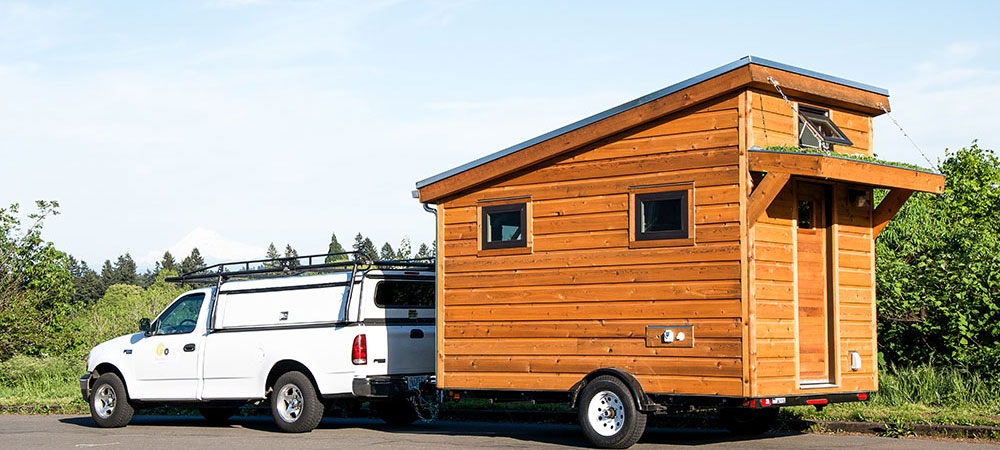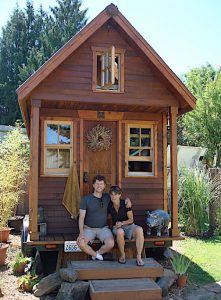
By Dee Williams
Years ago, a friend introduced me to 3D checkers. As a nerd, I loved this new spin on an old game; it demanded re-thinking the old moves, and it demanded a certain rigor and creativity that I loved.
Designing a tiny house is no different. Over the past several years, I’ve had a chance to meet many brilliant, creative tiny house designers and builders. Most recently, Shelter Wise has repeatedly knocked my socks off. That’s why we sell their tiny house plans. Every time I walk into one of their little houses, I see something new – the old standards disappear, something graceful appears, and the puzzle of life in a tiny house takes on a new solution.
The first time that sense of awe was overwhelming to me was when I met Jay Shafer of Four Lights Tiny Houses a decade ago. He inspired me to re-think what it means to design a space for myself, how to look at the volume of a house just as earnestly as we look at the square footage. I owe Jay endless thanks for encouraging me to move beyond my traditional architecture training, to consider design as a visceral experience. My book The Big Tiny comes out in paperback on April 22nd, and in this excerpt I provide homage to Jay. Cheers for all he’s offered to get our tiny house world rolling, and cheers for all the new designers out there like Shelter Wise, who are creating additional, beautiful possibilities all the time.
“Jay’s house was in a residential neighborhood, tucked behind a larger normal house, and as we walked to the backyard, we found him standing on his porch waiting for us, looking incredibly large given the small scale of his abode. I found myself approaching him with a mixture of complete excitement and hesitating fear…like a four-year-old seeing Santa at the mall. But I was too nervous to say anything funny or weird, and instead smiled and shook his outreached hand and mumbled, “I have a photo of you and your house stuck to my refrigerator,” which instantly made me feel like a miniature copy of that article was stuck in my teeth.
“Doesn’t everyone?” he said, putting his hands on his hips in a Superman pose and looking off in the distance like a statue. Apparently his sense of humor was on par with mine; I immediately liked him.

Before we went inside, while Doug and Jay talked on the porch, I walked around the house while gunning my hand along the siding and patting the window sashes. I loved Jay’s little house and found myself wanting to hug it, to lean into it and smell it or get my picture next to it like I was standing with the president. Inside, Jay gave us a short tour (a little joke at the time) and then we sat down around a tiny table with our knees touching. It felt like the sort of thing you’d do at a noisy café, where you’d naturally scoot in to hear each other and accidentally touch toes or kick each other when you cross your legs.
Jay pulled out a wad of papers and photographs, spreading them out on the small table between us, and then showed us floor plans and elevations, construction details, and sketches of some of the other houses he had designed. He and Doug chitchatted about how the house was connected to the trailer and how the walls were reinforced, and all the while I was mostly quiet. I glanced around at the knotty pine walls, the kitchen setup with its shiny galley sink and stainless steel countertop, and the way the cabinets were joined together. I casually cocked my head, trying not to seem overly nosy, as I read the titles of books stacked on the shelves—books about cabins, barns, tree houses, yurts, converted vans, an “Earthship,” old hippie wagons, shepherds’ wagons, chuckwagons, hay wagons, boats, and old Airstreams. His bookshelves looked like an expanded version of my own, and like my favorite part of the local bookstore where I’d spent hours in the past month crouched on a movable stepstool, till someone tapped me on the shoulder telling me it was closing time and I might as well collect all the books and just put them on the nearby stack table so an employee could reshelve them later…
Later that night, I tried to describe Jay’s house to Doug’s wife, Alecia. I talked about the cedar siding and the woodstove, and the way you could pop into the sleeping loft through a little cubbyhole near the kitchen. I explained how the space felt small but not claustrophobic, simple but not crude, and functional in that everything had a purpose and a place. I talked and talked, describing this detail and that feature, but ultimately Jay’s house was more than all those things. It was bigger.”
